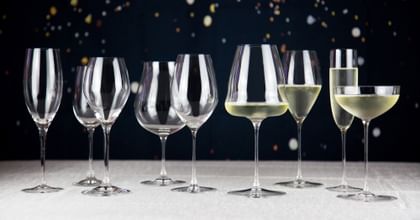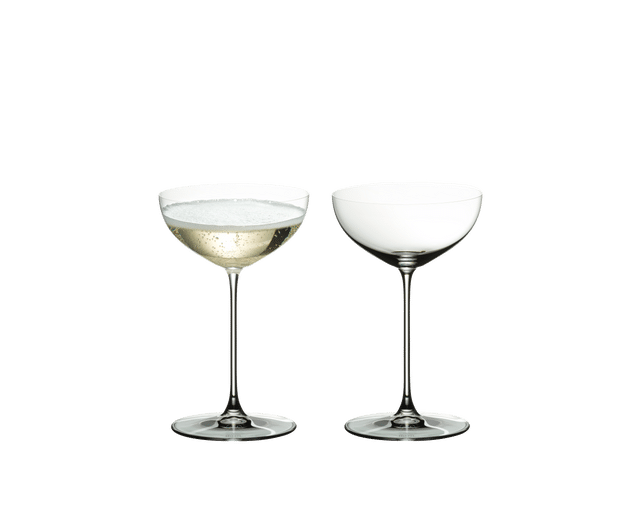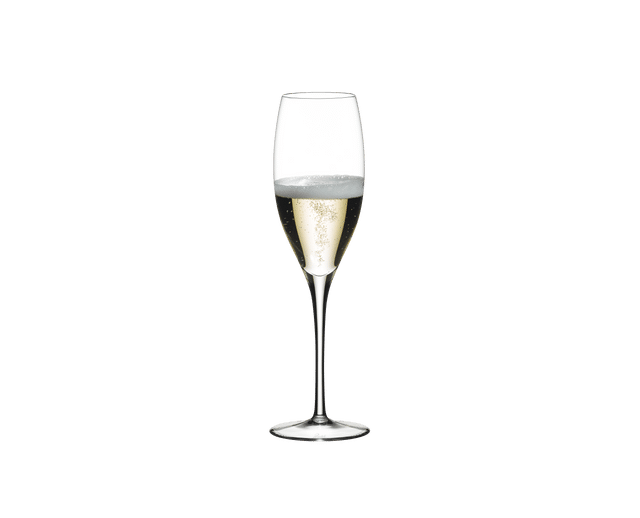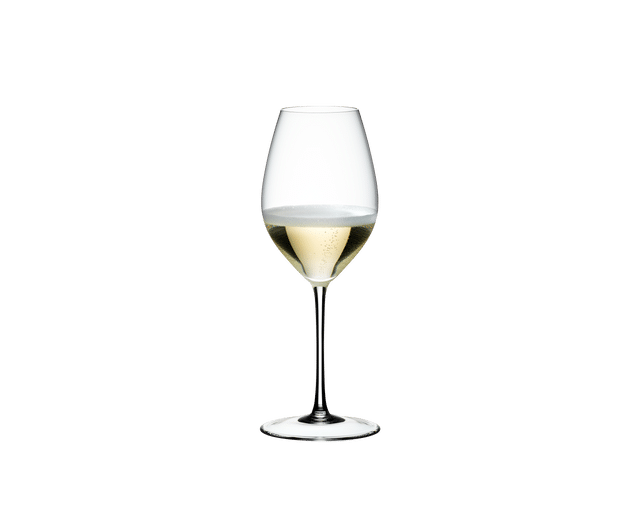Wissenswertes
Die Entwicklung des Champagnerglases

Es ist noch nicht lange her, da griffen die meisten von uns nach dem Öffnen einer Flasche Champagner automatisch zu ihren bewährten Flöten. In den vergangenen Jahren stellt sich jedoch die Frage, wie man Champagner serviert, um ihn optimal zur Geltung zu bringen. Seit über vierzig Jahren wissen wir, dass die Form eines Glases Einfluss auf die Wahrnehmung von Aroma und Geschmack hat. Warum sollten wir also bei Champagner weiterhin anders denken?
Ein Großteil von Champagner besteht aus drei Rebsorten - Pinot Noir, Chardonnay und Pinot Meunier - und einige der Herstellungsmethoden sind bei stillem Wein und Schaumwein ident. Der große Unterschied liegt in der Kohlensäure.
Stellen Sie sich vor, Sie haben eine gute Flasche Rotwein gekauft. Würden Sie ihn öffnen und in den nächsten Becher oder die nächste Tasse einschenken? Oder würden Sie ihn vielleicht dekantieren, die Temperatur überwachen, das beste Glas auswählen und ihn bei einer leckeren Mahlzeit genießen?
Wir tauschen gerne unsere Pinot Noir Gläser gegen Shiraz Gläser, wenn wir von einer Rebsorte zur nächsten wechseln. Warum also lassen wir es zu, dass die Bläschen des Champagners unsere Gewohnheiten dominieren? Das hat vor allem mit Tradition zu tun und damit, wie die Geschichte des Champagners unsere Vorstellung davon geprägt hat, in welches Gefäß er gehört.

Die Champagnerschale
Gerüchten zufolge soll die linke Brust von Marie Antoinette die Form dieses Glases inspiriert haben. Obwohl es eine schöne Geschichte ist, ist sie nicht wahr, denn das Glas entstand bereits vor der französischen Königin.
Allerdings war die Champagnerschale oder auch Coupeglas während ihrer Zeit auf dem Thron sehr beliebt, da der Champagner zu dieser Zeit süßer und sirupartiger war. Die kurzen Seiten des Glases und der flache Kelch erleichterten das Eintauchen von Kuchen in den Champagner. Etwas übertrieben, ja, aber seien wir ehrlich: Wenn Sie Ihr Dessert in Champagner tauchen könnten, würden Sie es nicht tun?
Das Glas erlebte in den 1920er Jahren ein Comeback, dann wieder in den 1960er Jahren und wurde vor einigen Jahren wieder populär, zur Enttäuschung leidenschaftlicher Champagnerliebhaber. Zwar kann man damit das Leben eines Flappers leben, aber seine Form ist völlig ungeeignet, wenn es darum geht, das Profil des Weins zum Ausdruck zu bringen.
Das offene Design führt dazu, dass sich sowohl die Bläschen als auch das Aroma fast sofort verflüchtigen, und wenn man bedenkt, dass 70 % unseres Geschmacksempfindens vom Geruch bestimmt werden, geht ein großer Teil der Geschmackserfahrung um der Mode willen verloren.
Was kommt nach der Sektschale?
Vor etwa fünfzig Jahren war Champagner wesentlich billiger als heute und damit für mehr Menschen zugänglich. Das mag zwar für die Branche positiv sein, aber die Champagnerhäuser konnten Qualität nur in einem begrenzten Umfang produzieren, und die Nachfrage war größer als das Angebot.
Also taten sie, was jeder intelligente Geschäftsmann tun würde: Sie veränderten den Diskurs über Champagner. So wie die Diamantenindustrie uns davon überzeugt hat, dass Diamanten die einzige Option für einen Heiratsantrag sind, so hat die Champagnerindustrie uns davon überzeugt, dass Champagner etwas Besonderes ist, das man sich für besondere Anlässe aufspart. Plötzlich konnten sie den Preis erhöhen, wodurch er weniger zugänglich wurde.

Die Flöte
Da Champagner heute vor allem für besondere Anlässe verwendet wird, brauchten die Menschen ein Glas, mit dem sie die Flasche mit mehreren Personen teilen konnten. Das schlanke Design der Flöte eignet sich perfekt zum Anstoßen und ermöglicht ein dosiertes Einschenken. So ist das Glas selbst zu einem Symbol für Feierlichkeiten geworden. Wenn Sie bei einem Freund zu Besuch sind und Champagnerflöten sehen, wissen Sie sofort, dass Sie eine gute Zeit vor sich haben!
Flöten haben auch den Vorteil, dass sie die Perlung verstärken. Alle Qualitätsprodukte verfügen über einen kleinen Kratzer oder eine Markierung am Boden, die den Champagner aufwirbelt und dafür sorgt, dass er beim Trinken sprudelnd bleibt.
Der Nachteil ist, dass sie aufgrund ihrer dünnen Öffnung das Aroma nicht perfekt zum Ausdruck bringen können. Selbst tulpenförmige Flöten mit abgerundeten Schalen bieten nicht das volle aromatische Erlebnis.
Im Jahr 2013 begann RIEDEL mit der Veranstaltung von Sensory Workshops, um die beste Glasform für Balance und Ausdruck zu finden. Wir entdeckten, was wir schon lange vermutet hatten: Das beste Glas zum Genießen von Champagner ist ein Weinglas.
Beim Genuss von Champagner aus einem Weinglas geht es genau darum - um das Getränk. Es verwandelt Champagner von etwas, das nur zum Anstoßen gedacht ist, in etwas, das es wert ist, genossen zu werden. In unseren Workshops haben wir zwei Formen ermittelt, die je nach Art des Champagners am besten geeignet sind.

Das Glas
Ein hohes Weißweinglas in Tulpenform eignet sich besser für schlanke Champagner wie den Blanc de Blanc, der hauptsächlich aus Chardonnay-Trauben hergestellt wird. Die bescheidene Größe des Kelches entfaltet die Aromen, ohne sie zu überwältigen, vor allem bei Jahrgangschampagnern, bei denen die Eigenschaften im Laufe der Zeit komplexer geworden sind.
Zur Aufwertung der reichhaltigeren Rosé-Champagner, die hauptsächlich aus den Rebsorten Pinot Noir und Pinot Meunier gewonnen werden, ist der Kelch der Neue World Pinot Noir Gläser unschlagbar. Sie übertrifft die Flöten um Längen und zeigt eine beeindruckende Charaktertiefe.
Unsere RIEDEL Veritas Kollektion ist das weltweit erste Glas (keine Flöte), das speziell für das Genießen von Champagner entwickelt wurde, so wie man auch Wein trinken würde. Das RIEDEL Veritas Champagner Weinglas hat einen geschwungenen, eiförmigen Kelch mit einer kleinen Öffnung, die das Aroma umschließt.
Seither haben wir Vergleiche zwischen Flöten und Gläsern mit Weinliebhabern durchgeführt, und alle Teilnehmer sind immer wieder erstaunt über den Unterschied, den das Glas macht. Das Ergebnis ist, dass alle neueren Serien von RIEDEL mit dieser Kelchform für Champagner anstelle einer Flöte entwickelt werden.
Wie es Maximilian J. Riedel,11. Generation, es ausdrückt: "Champagner ist ein Wein und verdient es, als solcher behandelt zu werden. Ob beim Genuss eines Blanc de Blancs oder einer Cuvée, unser Champagner Weinglas lässt die Aromenvielfalt des Champagners in einer Weise zur Geltung kommen, wie es mit einer schmalen Flöte nicht möglich ist."
Was bedeutet das nun alles?
Beide Seiten der Debatte werden nach wie vor kontrovers diskutiert. Dom Pérignon soll das erste Champagnerhaus gewesen sein, welches die Flöte als bevorzugtes Champagnergefäß eingeführt hat, weil er es genoss, "den Tanz der sprudelnden Bläschen zu beobachten." Olivier Krug, der heutige Direktor von Krug und Ur-Ur-Ur-Enkel des Firmengründers, ist hingegen der Meinung, dass "ein großartiger Champagner in einem schmalen Glas nicht seinen vollen Ausdruck entfalten kann."
Welches Champagnerglas für Sie am besten geeignet ist, hängt davon ab, wie und wann Sie Champagner genießen und welche Stile Sie gerne trinken. Zwar würden wir Ihnen nicht empfehlen, Jahrgangschampagner aus einem Plastikbecher zu trinken, aber vielleicht sind Sie ein begeisterter Traditionalist, der an der klassischen Flöte nicht vorbeikommt, oder Sie lieben es, der Zeit voraus zu sein und trinken Champagner aus Ihren stiellosen O Wine Tumblern.
Wenn Sie allerdings für ein Glas des edlen Tropfens über glühende Kohlen gehen würden, sollten Sie beim nächsten Mal, wenn Sie etwas Besonderes öffnen, einen schnellen Glasvergleich durchführen. Unsere einzige Warnung: Versuchen Sie das nicht mit vielen Gästen, denn wenn Sie einmal Champagner aus einem Weinglas getrunken haben, wollen Sie vielleicht nicht mehr teilen!
Standorte